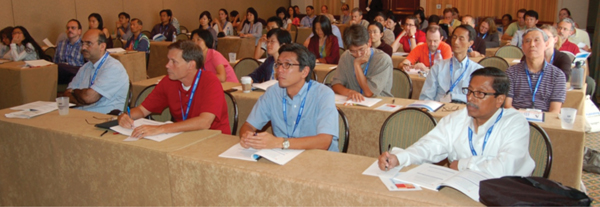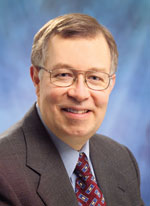Continuing Professional Development: New Kinds of Learning for Statisticians

JSM attendees absorb new methodology at a course offered by the ASA’s Continuing Education program. Additional types of learning are needed in emerging areas of statistical practice.
This month, thousands of our members are looking forward to the Joint Statistical Meetings (JSM) in San Diego. For many, the most valuable activities at JSM will be the 26 short courses and 13 computer technology workshops available on topics from ordinal categorical data to data mining. This column explains the success of the ASA’s Continuing Education (CE) program and describes other kinds of continuing professional development our association should support.
Why Is the CE Program So Popular?
For answers to this question, I turned to members who regularly attend courses at JSM. David Ipe, a statistician at Genentech, often finds that the methods he learns are directly applicable to his projects. He cites courses in randomization methods, survival analysis, and meta-analysis that have benefited his work since the 1990s.
During most of his career, Bob Yaffee, a research professor at New York University, has used the CE program to explore areas of interest. He is currently analyzing data about Chernobyl survivors with techniques gained from courses on multiple imputation, bootstrapping, and multilevel modeling.
Bill Kahn, head of science for Chartis Commercial Insurance, says, “CE classes are a blast because they are taught by the world’s best statistical professionals, they provide the breadth and depth you need as practicing statisticians, and they are a great way to meet others and build your professional network.”
Behind the Scenes of the CE Program
A major factor in the success of the CE program is the thoughtful planning of the Advisory Committee on Continuing Education (ACCE) and others who review course proposals submitted in September and select those that will be presented at JSM the following year.
Most proposals come from authors of recently published books, and two-thirds of the proposals are sponsored by sections. Overall, CE courses generate revenue for our association, and this is shared with the sponsoring sections.
The ACCE also evaluates feedback collected from attendees. Mary Christman, chair of the committee, explains, “We use that information to ensure we have highly qualified instructors and topics that are of interest.” Outstanding courses are recognized with the Excellence in Continuing Education Award.
Serving on the ACCE is a major time commitment, but Christman adds, “We are, by nature, teachers who feel motivated to improve the training and knowledge of ASA members. We want the courses to be current, useful, and even inspiring for attendees.”
Courses Throughout the Year
ASA-supported training does not end at JSM. Through the Council of Chapters, CE instructors can be invited to present traveling courses to ASA chapters.
Webinars organized by sections are another learning opportunity, and they are gaining popularity because they are accessible and cost effective. During the past year, 20 webinars have been scheduled, including one on Bayesian computational methods offered by the Section on Bayesian Statistical Sciences and one on interview strategies offered by the Section for Statistical Programmers and Analysts.
In addition, the next ASA Conference on Statistical Practice, which will take place February 21–23, 2013, will again feature short courses and tutorials.
New Areas of Learning
To equip statisticians for future success, we must build on the success of our CE offerings—which focus on methodology—and expand into other areas of training. These areas include computational techniques for big data, domain knowledge required for interdisciplinary research, and career development skills.
Big data presents us with novel learning requirements driven by the question, “What would you do with all this data?” Increasingly, the answer depends on our ability to work with data from social media sites, website logs, and medical records—and so we must learn how to access and incorporate textual data into our analyses.
Moreover, because so much big data is stored across clusters or grids of multiple computers, we also must learn about distributed computing. Expertise in manipulation of large data sets and the ability to analyze distributed data are already critical for statistical scientists in fields such as drug discovery and statistical genetics.
Along with learning to employ new computational tools, statisticians must become knowledgeable about problem domains in research, business, and government organizations where the demand for data analysts is surging. For statisticians in corporate environments, Bill Kahn reinforces the importance of learning about the business, pointing out that “if all we know is statistics, we will always be outsiders rather than influencers.”
In any statistical endeavor, our contributions will be valued far more if we learn to write and present in ways that clearly explain the relevance of what we do to the goals of our collaborators and our organizations. Likewise, the visibility and effect of our contributions will be amplified if we learn how to lead and influence others. New ASA training in these areas is being developed by the 2012 Career Success Factors Workgroup, led by Robert Starbuck, who will report on their progress in a future column.
Continuing Professional Development
To provide the various types of ongoing learning that statisticians will need, the ASA Board of Directors is developing a long-term plan. The board has adopted the term “Continuing Professional Development (CPD)” for the process of improving and broadening the knowledge and skills required for successful statistical practice. In all, the board has identified four areas of CPD:
-
1. In methodology and practice, by keeping abreast of new techniques and theory, staying connected with best practice, growing in areas not previously studied (or refreshing forgotten material), and gathering ideas and direction for research
-
2. In technology, by learning about new computational techniques and software tools, as well as trends in technology and new sources of data that are creating major new opportunities for statisticians
-
3. In subject matter necessary for successful collaboration with other scientific disciplines and for working in teams in business and government
-
4. In career success factors such as communication, leadership, and influence skills
Clearly, statisticians already pursue CPD through a variety of existing ASA activities, including our journals, meetings, and CE program. The preceding list is a framework for understanding where we should expand our efforts. By doing so, we will not only respond to emerging needs within our membership, but we will also retain as members more of our students who graduate and then encounter these needs in their workplaces. We also will make the ASA an attractive professional home for data scientists, business analysts, and other statistical problemsolvers.
When Do We Stop Learning?
It is vitally important for our association to support continuing professional development. Bob Yaffee summarizes it perfectly: “Statisticians must keep current if we are to remain relevant and educated. This kind of learning is a way of life in which we are forever students. We don’t stop until we drop.”


















